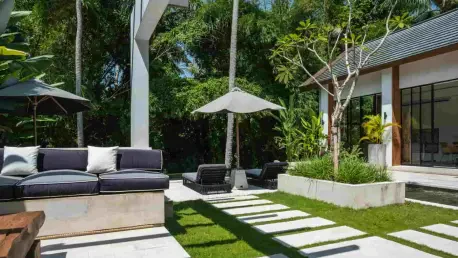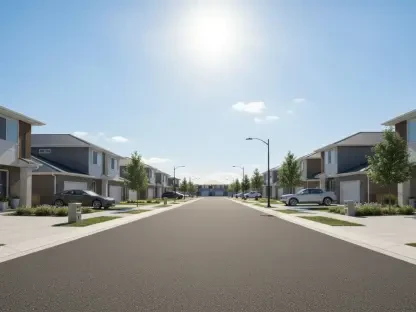The idea of transforming outdoor spaces has always intrigued those who seek personal retreats amidst urban landscapes. Minimalist garden design offers a uniquely calming approach, providing a serene escape from the chaos of everyday life. This design philosophy is gaining traction for its ability to create tranquil environments, regardless of the size of the space available. The allure lies in its simplicity, clean lines, and focus on functionality, all while maintaining an elegant aesthetic. Gardens designed with minimalism in mind are characterized by intentional choices in elements like color palette, plant selection, and materials to create an uncluttered and harmonious atmosphere that captivates and calms.
Cultivating Tranquility Through Simplistic Design
The Role of Color and Plant Selection in Minimalist Gardens
In the realm of minimalist garden design, color palette and plant selection play pivotal roles in achieving a cohesive and tranquil atmosphere. The primary aim is to reduce visual clutter by sticking to a restrained and harmonious color scheme. This is often achieved by using a limited spectrum, frequently focusing on greens paired with whites or blues. These choices help in maintaining a calm and systematic appearance, with each element complementing rather than competing for attention.
Renowned garden designer Alexander Betz proposes using green, blue, and white plants that share similar growth conditions, which results in a unified and balanced look. Linda Vater offers further insights by suggesting ‘green washed’ gardens where subtle variations of green plants or single-color blooms like white not only add depth but also extend the visual appeal of the garden into the twilight hours. This deliberate limitation in color selection can also attract nocturnal pollinators, enhancing the garden’s ecosystem.
Plant selection is equally critical in a minimalist garden. It often involves choosing species that offer structural interest and low maintenance. Experts like Shireen Zia showcase how selections like Japanese maples and certain topiary spheres contribute to minimalism through their sculptural quality and understated beauty. These recommendations emphasize quality over quantity, ensuring the garden remains a reflection of tranquility and simplicity.
Material Choices and Their Impact on Minimalism
Material choice is quintessential in echoing the minimalist aesthetic. The guiding principle here is to use no more than three different materials for garden elements like pathways, patios, and furniture to maintain visual clarity. This restriction helps prevent clutter, further amplifying the serene ethos of minimalist design. Ellen Mary champions the combination of concrete, wood, and shingle for their practicality and aesthetic alignment with minimalist values.
Adding depth to this conversation, Shireen Zia discusses using neutral-tone gravel alongside structured plantings to imbue warmth while maintaining clean lines in the design. The goal is to create a cohesive look where every material serves a purpose, either functionally or aesthetically, without overwhelming the senses. It’s about crafting a garden that not only looks exquisite but also feels intentionally arranged.
Repetition serves as another potent tool. By repeating elements, such as rows of similar plants, designers can strengthen the minimalist theme. This technique promotes uniformity and tranquility throughout the garden, blurring the line between nature and design. Recommendations from experts like Linda Vater include repetitive use of texturally rich but visually uniform plants like ‘Soft Caress’ Mahonia, which offers varied yet subtle seasonal colors.
Maintaining Functionality and Order
The Importance of Functional Design Elements
Functionality stands as a cornerstone in minimalist garden design. The central idea is to create spaces that are not only visually pleasing but also practical and usable. Essential design elements, like seating and focal features, should be integrated thoughtfully, serving both aesthetic and utilitarian purposes. For instance, incorporating sculptural seat-walls can anchor the garden’s design, presenting a deliberate focal point while offering a comfortable resting space.
Garden design experts, such as Alexander Betz, advocate for including landscape features like birdbaths at strategic points within the garden. These elements can unify different sections of the garden, providing continuity without compromising its minimalist integrity. Design considerations should ensure that these functional attributes are seamlessly woven into the overall design narrative.
A well-maintained garden aligns with the principles of minimalism, where everything is curated and purposeful. This includes being diligent about clutter management by concealing tools and accessories through dedicated storage solutions. Regular maintenance, such as weed removal and pruning, further extends the garden’s pristine appeal, ensuring that tranquility is preserved through consistently clear and organized spaces.
Scale and Adaptation in Minimalist Designs
The principles of minimalist design extend beyond vast landscapes and can be skillfully adapted to small spaces, such as atriums and compact urban settings. The challenge lies in balancing scale with simplicity, ensuring the area remains inviting without appearing confined. Shireen Zia’s work illustrates how compact spaces can adopt minimalist design to emanate a Zen-like tranquility.
Scale variations should be respected when selecting plant species and materials to maintain spatial harmony. Opt for plants and features that complement the space’s proportions and offer visual interest without overpowering the area. For instance, small clipped topiary spheres, grasses like carex, and ground covers such as thyme and blue star creeper offer both structural and aesthetic benefits.
Expert guidance is invaluable when selecting appropriate plantings, recommending those with sculptural quality and low maintenance needs. By focusing on species like Japanese maple, lavender, and shrub roses, the garden can maintain its elegance and remain relatively uncomplicated to care for. This ensures that even smaller gardens can reflect the broader minimalist aesthetic principles and provide a comparable degree of peace and order.
Embracing the Minimalist Design Philosophy
Expert Insights and Best Practices
Minimalist garden design is as much about adhering to philosophical principles as it is about practical execution. Several themes emerge consistently, such as the advocacy for restraint in plant variety, texture mixing, and color palettes. The crux of successful minimalist design resides in carefully chosen, limited variety offering a more impactful and serene environment, a sentiment echoed by numerous landscape professionals.
The overall trend among design experts promotes cultivating gardens that exhibit not only visual calm but also foster an internal sense of peace and order. This ties directly into broader minimalist concepts seen within interior spaces, emphasizing functionality, simplicity, and the ethos of less being more. By adopting these principles, gardens transform into serene retreats that require simplicity in maintenance without sacrificing elegance or purpose.
Moreover, minimalist gardens resonate with current lifestyle preferences where convenience pairs with aesthetic value. The design ethos aligns with the modern inclination towards spaces that are accessible and maintain their allure throughout the seasons. For those interested in aligning their outdoor environments with minimalist values, there is a clear roadmap to obtaining a meaningful, elegant, and rewarding garden experience.
Creating Lasting Serenity with Minimalist Gardens
The concept of transforming outdoor areas into personal havens is a captivating idea for those who yearn for a peaceful escape within urban settings. Minimalist garden design is increasingly popular due to its ability to offer a serene refuge from the daily hustle and bustle. This design ethos focuses on cultivating tranquility, regardless of the space’s size, through simplicity and elegance. The charm lies in its ability to blend clean lines and functionality with a sophisticated aesthetic, creating spaces that are both beautiful and practical.
In minimalist gardens, every element is thoughtfully chosen to enhance harmony and relaxation. This includes selecting a well-balanced color palette and deciding on the types of plants and materials that best complement one another. The result is an uncluttered and soothing environment that promotes a sense of peace and well-being.
These gardens encourage a deeper connection with nature, allowing individuals to unwind and rejuvenate. The minimalist approach strips away excess, offering a purposeful and intentional landscape that stands out in urban environments. Whether you have a sprawling backyard or a modest balcony, minimalist garden design can transform any space into a personal sanctuary, where the stresses of daily life can temporarily fade away, and a profound sense of calm can take its place. As such, it continues to attract those seeking to enhance their quality of life through natural beauty and mindful design.









